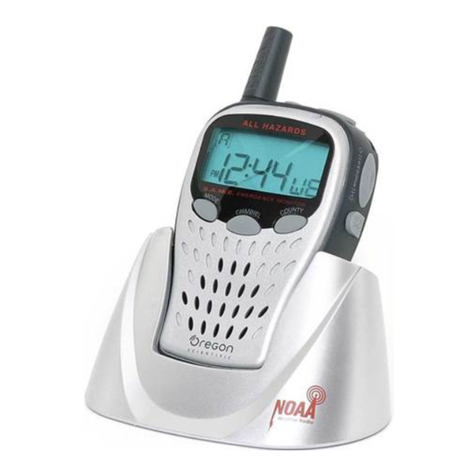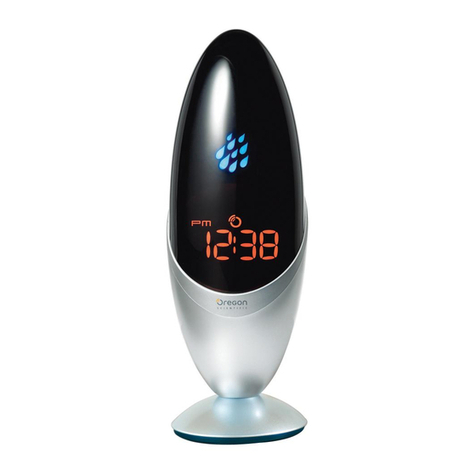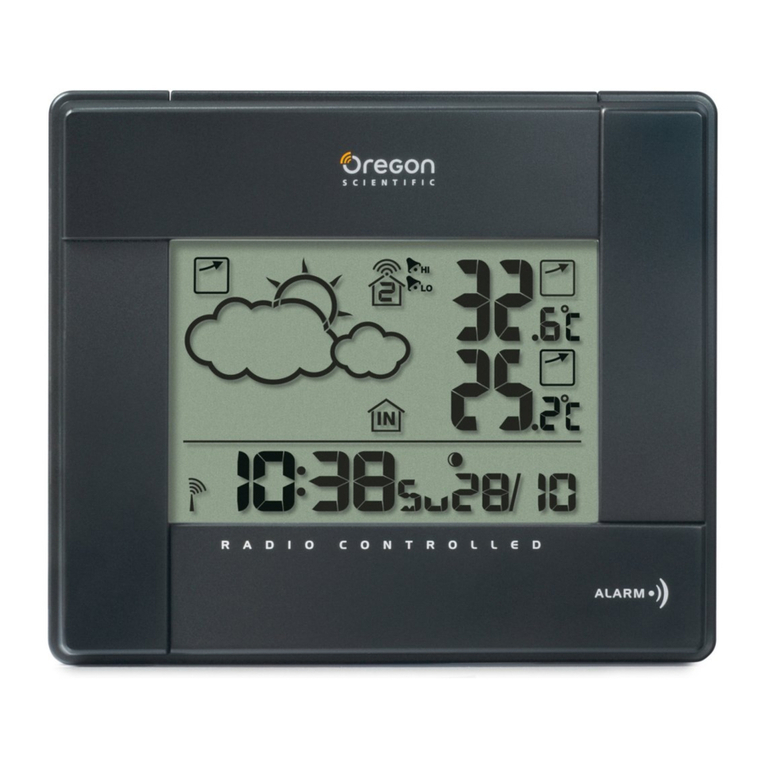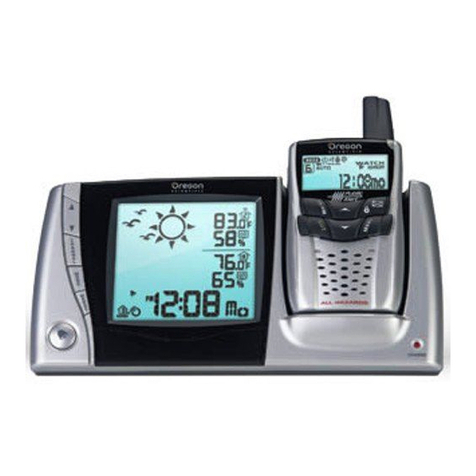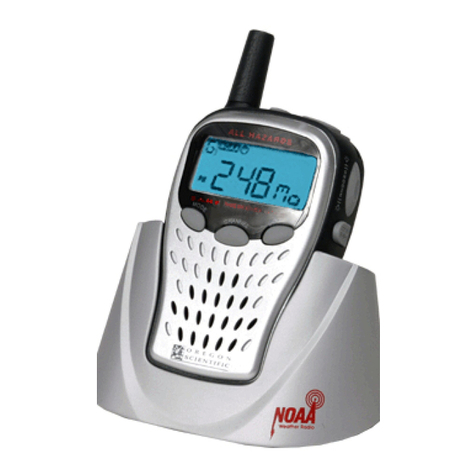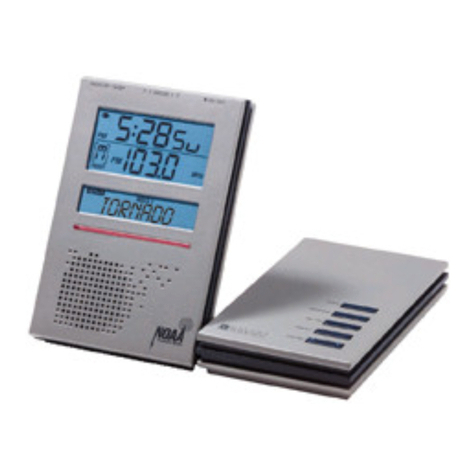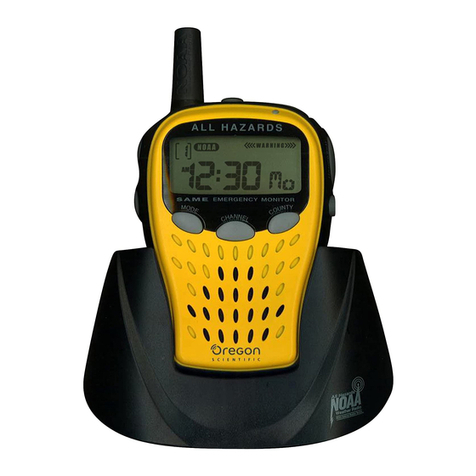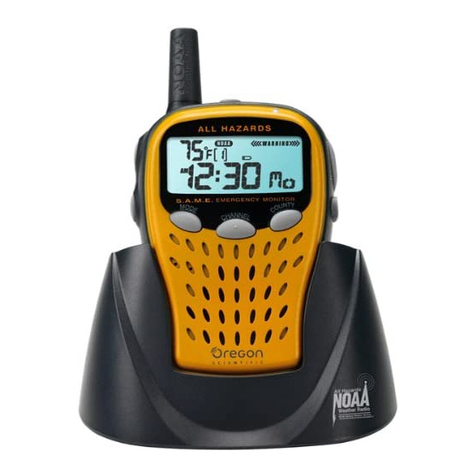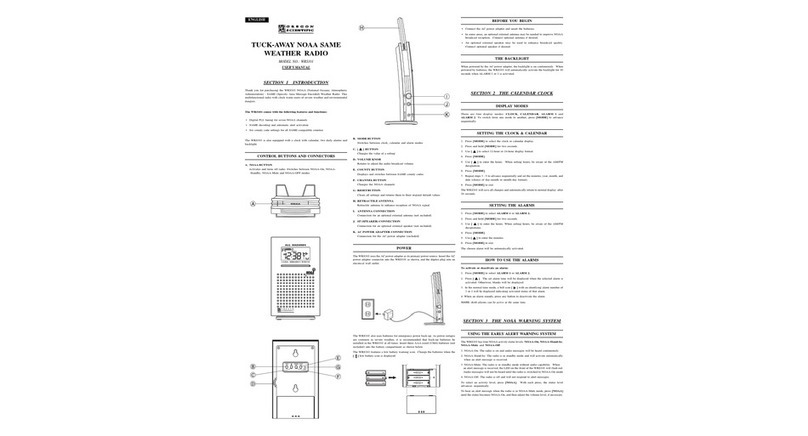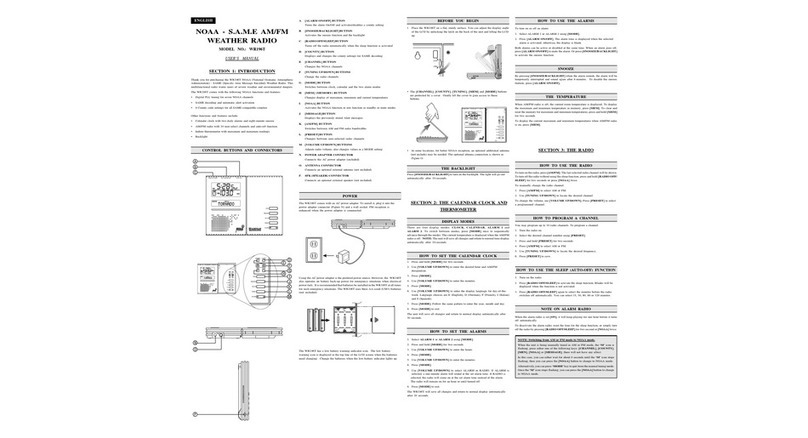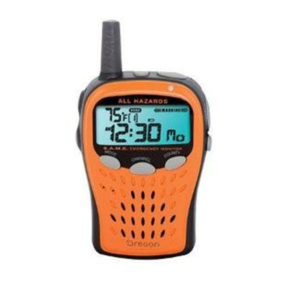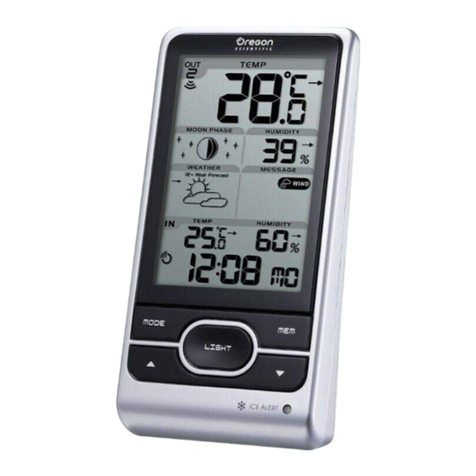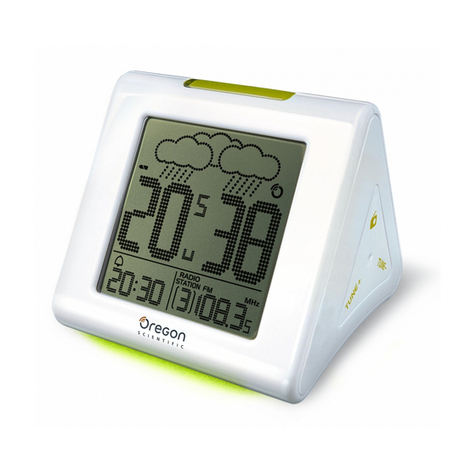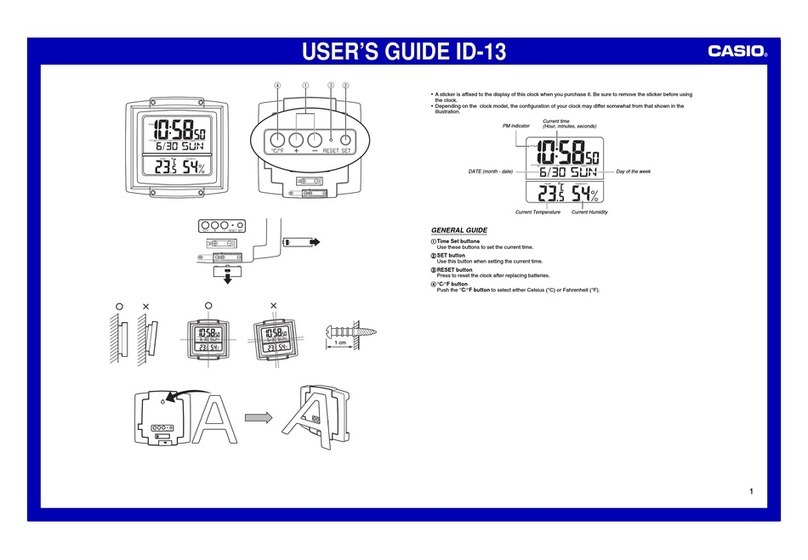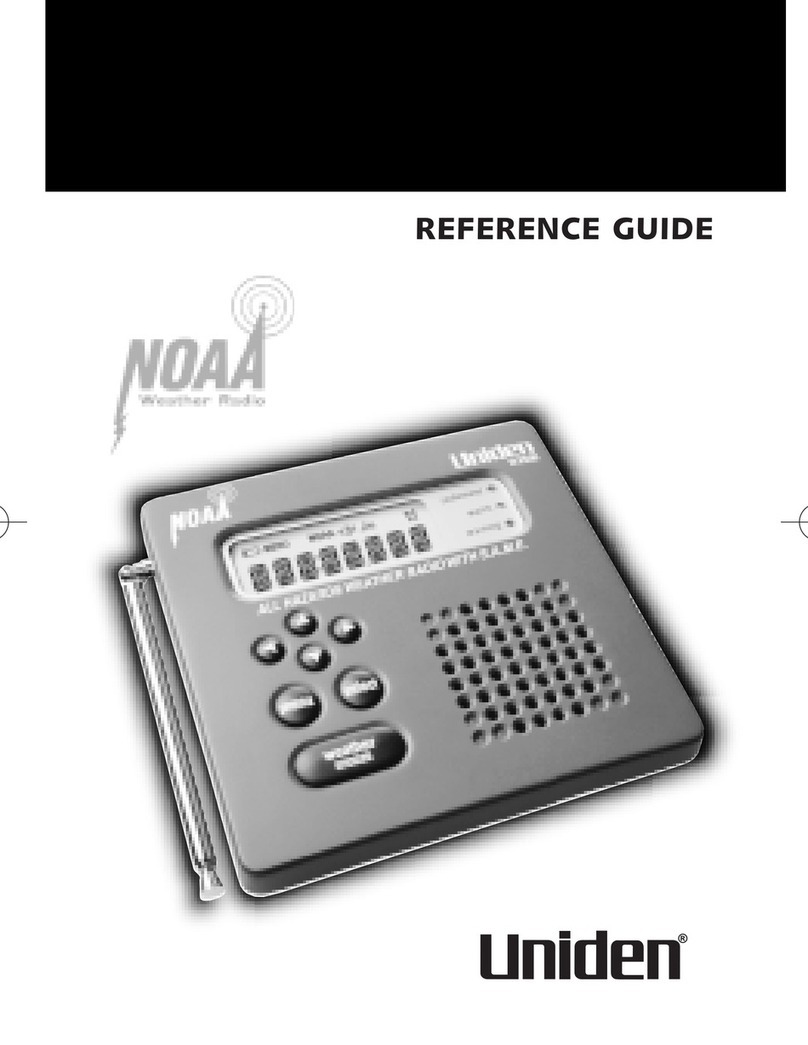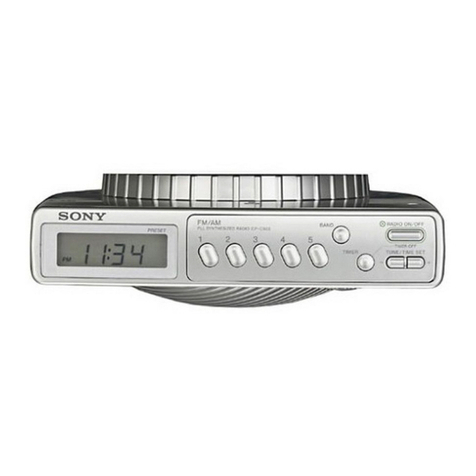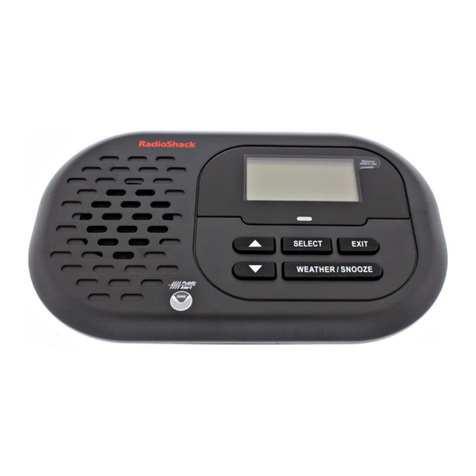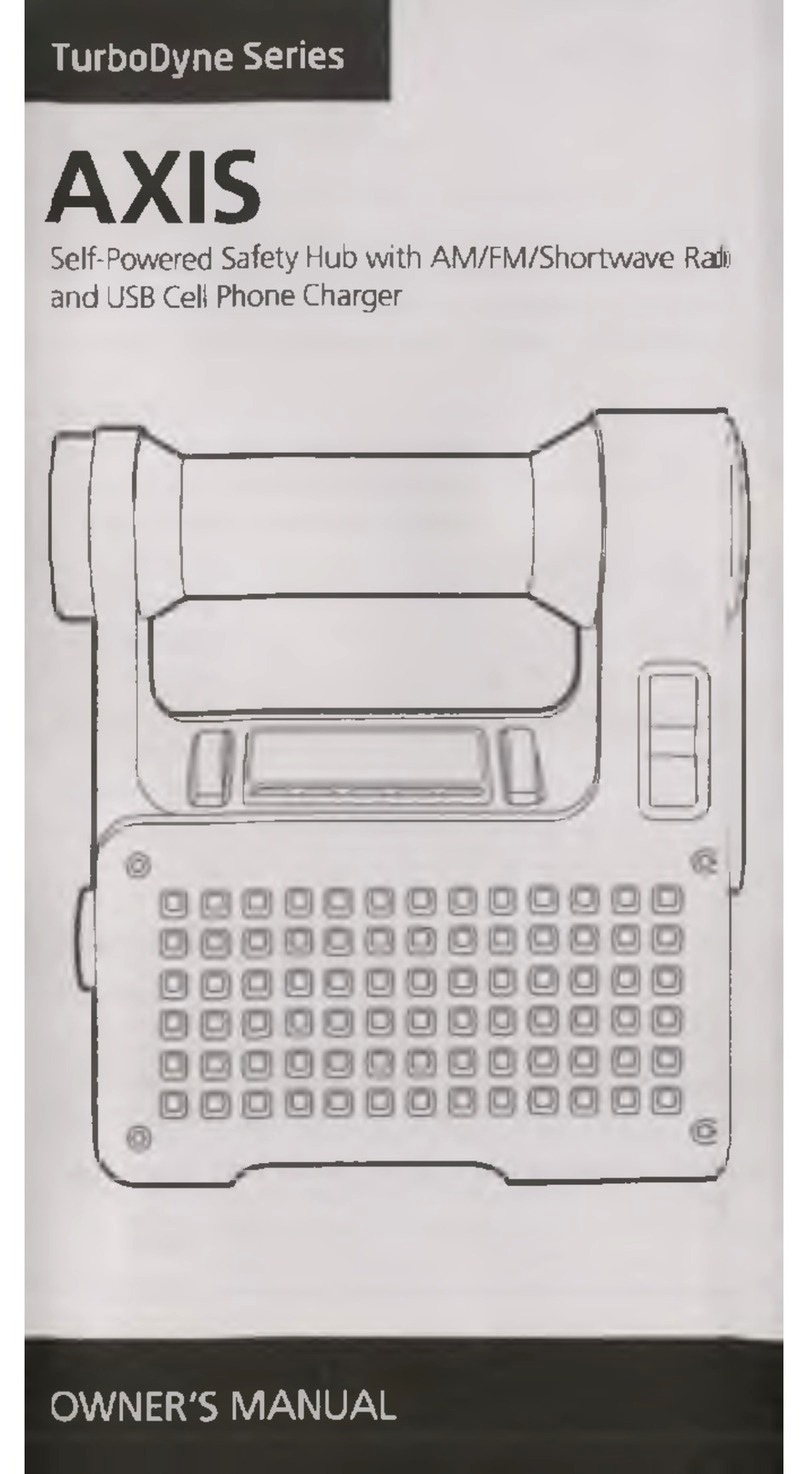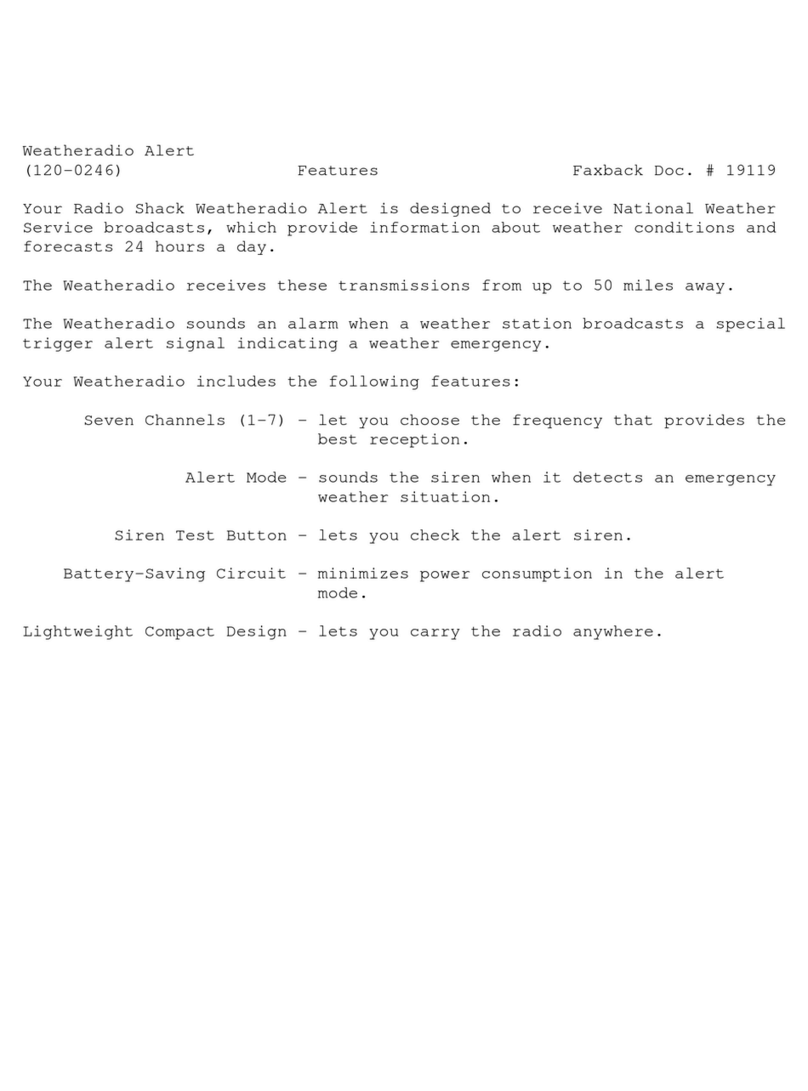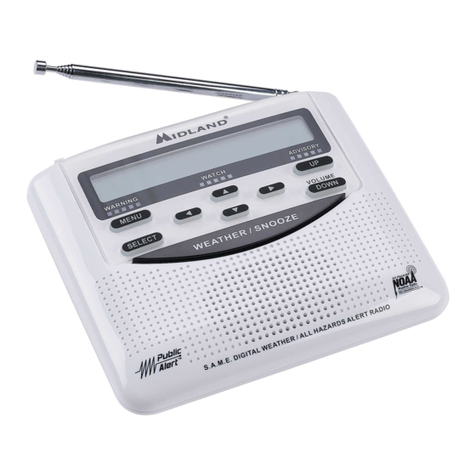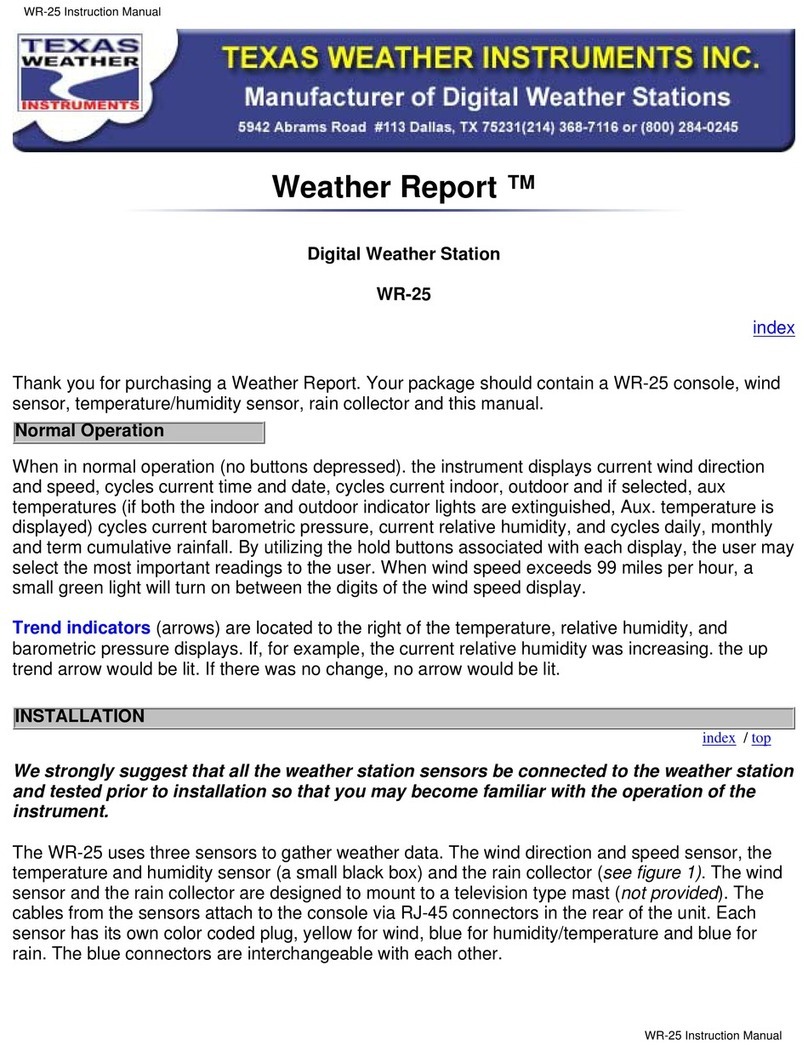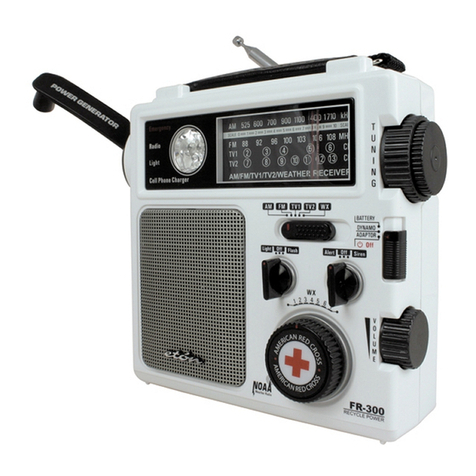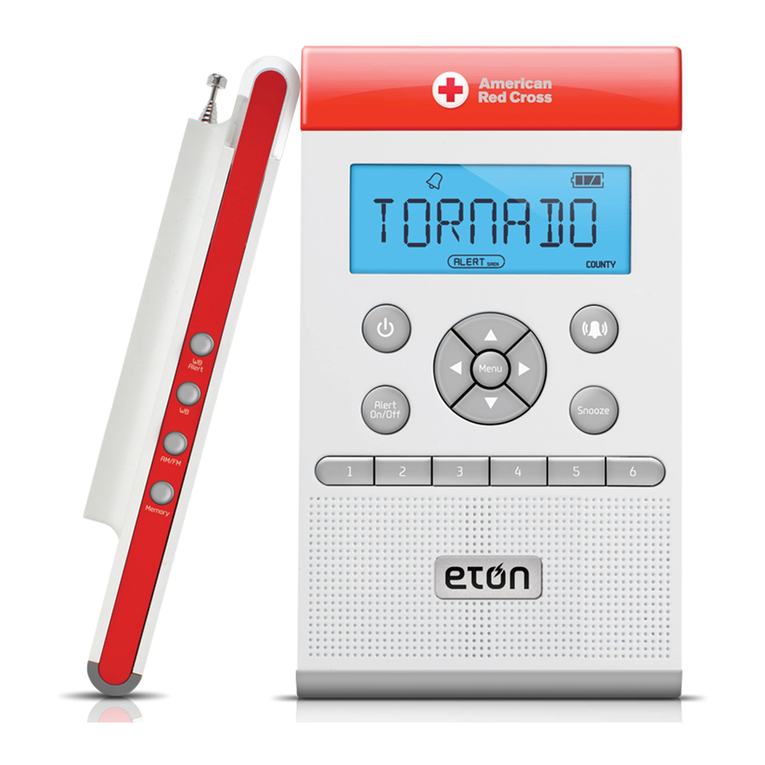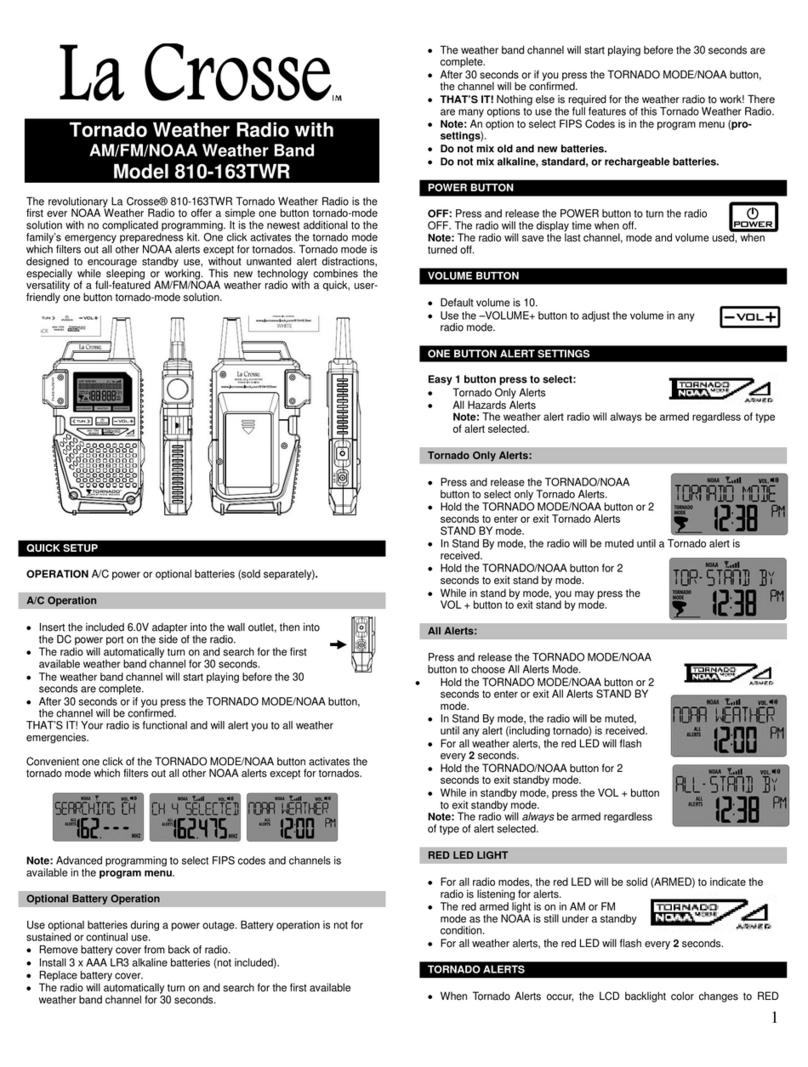NOAA WEATHER RADIO WITH 14-CHANNEL FRS
Model: WRF 108
USER’S MANUAL
Fig.1
Fig.2
Fig.3
Fig.4
Fig.5
Fig.6
Fig.7
Fig.8
Fig.9
Fig.10
English
INTRODUCTION
Congratulations on your purchase of Oregon Scientifics’ NOAA
Weather Radio with 14-channel FRS (Model No. WRF108). Your
NOAA Weather Radio with FRS is a portable, easy-to-use, two-way
radio with clock and NOAA receiver. You can use the WRF108 to talk
over the radio as well as listen to NOAA WX broadcasts and at the
same time use it as a clock. Use it at shopping malls, amusement parks,
sports events, or at the beach to contact family and friends, or for vital
communications in a neighborhood watch.
Your NOAA Weather radio with FRS has 14 channels and 38 different
CTCSS codes. If the channel you selected is already in use, you can
select another channel or use the CTCSS feature. You can talk with a
person who has a FRS radio if both radios are tuned to the same
channel and CTCSS code.
The radio has auto-squelch (FRS only), which means you will not hear
anything on a channel unless someone is transmitting nearby on the
same channel. You can turn off auto-squelch to hear weaker, distant
transmissions.
Also, if the radio is idle for a period of time of 2 hours, it
automatically shuts off. It turns on again when you press
POWER/VOL key for 2 seconds.
You can connect an optional speaker/microphone, earphone and
charger (not included) to the radio. And, the belt clip lets you take
your radio almost anywhere.
ABOUT THE NATIONAL WEATHER-RADIO SYSTEM
The National Weather Service (NWS) is an agency within the National
Oceanic & Atmospheric Administration (NOAA) that operates a
nationwide network of radio stations known as the NOAA Weather
Radio (NWR). The NWR radio system broadcasts warning information
for all types of hazards both natural and technological. Working in
conjunction with the Emergency Alert System (EAS). NWR is referred
to as an all-in-one hazards radio network. It is viewed as being a single
source of comprehensive weather and emergency information.
A nation wide network, the NWR consists of more than 480 stations in
the 50 US states and near adjacent coastal waters of Puerto Rico, the
U.S. Virgin Islands and U.S. Pacific Territories. Broadcasts are
designed to meet local needs. Routine programming is repeated every
few minutes and consists of local forecast, regional conditions and
marine forecasts. Additional information, including river stages and
climatic data, is also provided. During emergencies, these routine
broadcasts are interrupted to report specific warnings, watches or other
critical information.
USING THE RADIO
A. DISPLAY (Fig.1)
Your radio comes with a multifunction display with Hi-Glo backlight.
In clock mode before turning on the radio, pressing
MONI/FUNC/NOAA or POWER/VOL button can turn on the backlight
for 7 seconds. In working mode, by pressing any button except the PTT
will turn on the backlight for 7 seconds.
1. Shows the selected channel number.
2. Shows the selected CTCSS code number.
3. Shows the selected county code for NOAA.
4. “ ”: Displays when your radio is in county code
entering mode.
5. “ ”: Displays when a call is being received.
6. “ ”: Displays when your radio is transmitting or the PTT
button is pressed.
7. “ ”: Displays when the secondary function is enabled.
8. “ ”: Displays when the scan mode is activated.
9. Shows the sequence number of the county your entered or the
pertinent NOAA frequency code.
10. “ ”: If this icon flashes, it indicates the batteries are low.
Replace the batteries when it appears.
11. “”: Displays when the key tone function is activated.
12. “ ”: Displays when the keypad lock is activated.
13. “ ”: Displays when the courtesy tone function is
activated.
14. “ ”: Displays when VOX function is set to be low.
15. “ ”: Displays when VOX function is set to be high.
16. “ ”: Displays when intercom function is enabled. (Assume the
intercom accessories are used.)
17. “ ”: Displays when your radio is in NOAA ON mode.
18. “ ”: Displays when your radio is in NOAA stand by mode.
19. “ ”: Displays when your radio is in NOAA mute mode.
20. “ ”: Displays when an
alert signal is received during the NOAA mode.
B. FUNCTION AND LOCATION OF THE CONTROLS (Fig.2)
1. POWER/VOL Button
2. MENU/KEYLOCK Button
3. COUNTY/CTCSS Button
4. UP Button
5. DOWN Button
6. Battery Compartment
7. MONI/FUNC/NOAA Button
8. PTT (Push To Talk) Button
9. External Speaker/Microphone Jack
10. Charger Jack
C. FUNCTION AND OPERATION OF THE FRS RADIO
Preparation
Your radio requires 4 AAA batteries for power supply. We recommend
alkaline batteries. However, you can also use rechargeable batteries in
the radio.
To start using your radio, insert four AAA batteries into the battery
compartment, noting the polarities.
As soon as you connect the power, the unit will enter the clock mode
and 00:00 will display on LCD.
Note: Once your batteries are used up, you should replace all the four
alkaline batteries with new ones. The clock will be set to 00:00
and need to be reset again.
Turning On/Off Your FRS Radio
Press and hold POWER/VOL button for about 2 seconds. An audible
tone will be sounded to indicate your FRS radio is on. (The unit will
return to the last state before turning off) The same operation will turn
off the radio and return to clock mode.
Adjusting Volume
Volume can be adjusted to 8 levels. When your radio is turned on,
momentarily press POWER/VOL button to enter into the volume-
adjusting mode. Repeatedly press UP or DOWN button to adjust
volume until you get a comfortable level. Press POWER/VOL button
again or do not press any button for 5 seconds, the radio will exit this
mode.
Key Locking
You can lock your radio setting to avoid accidental pressing of keys by pressing
and holding MENU/KEYLOCK button for more than 2 seconds. The function is
effective to all keys except the PTT key, the 2 second-press of the
MONI/FUNC/NOAA button for the monitor function and the
POWER/VOL key for turning off the radio.
Setting VOX
Pressing the UP key while holding MONI/FUNC/NOAA button can
toggle between VOX on/off. If the UP key is held down for more than
2 seconds, the unit will enter the toggle mode between high and low
levels of VOX control sensitivity.
Modes Description
1. Press MENU/KEYLOCK button to toggle among modes of
FRS, NOAA and FRS+NOAA. (Fig.3)
2. FRS: FRS only.
NOAA: NOAA only.
FRS+NOAA: In FRS mode but keeping watch for NOAA
alert signals. When a NOAA alert signal is
received, FRS radio will automatically be
switched to the NOAA mode. (No CH scan
function in this mode)
FRS Operation
Select the desired channel and/or CTCSS code. To transmit, hold down
PTT. Release when you finish.
Monitor Function
To hear everything happening on a channel, including weak
transmission, hold down MONI/FUNC/NOAA button for more than 2
seconds. Release the MONI/FUNC/NOAA button to turn the auto-
squelch back on.
Auto Power Save
When in FRS mode your radio has a unique circuit designed to extend
the battery life.
Selecting Channel and Channel Scan Function
1. Repeatedly press UP or DOWN button to select the current
working channel desired. The selected channel number
appears.
2. Press and hold UP or DOWN button for more than 2 seconds to
enter the channel scan mode and “SC” is displayed on the
LCD. The radio automatically scans through the channels and
stops for about 5 seconds on each active channel. During
scanning, pressing UP or DOWN button can change the scan
direction. Press any button except UP and DOWN to make your
radio exit the scanning mode and stay on the current scanned
channel. If you want to exit scanning and be on the original
channel before scanning, you can press COUNTY/CTCSS
button. (Note: Channel scan function is effective only in FRS
mode.)
CTCSS Code Setting
Press and hold COUNTY/CTCSS button for about 2 seconds during
normal operation to enter the CTCSS code setting mode. The CTCSS
code on LCD will flash. Press continually the UP or DOWN button to
select the desired quiet code. Once more press COUNTY/CTCSS
button to confirm and then exit.
Other Settings of FRS Radio
When the last mode before you turned off your radio was FRS mode,
hold down COUNTY/CTCSS button and power the radio by pressing
POWER/VOL button to enter into the setting mode. Repeatedly
pressing COUNTY/CTCSS button can toggle among the settings of
KEY BEEP, C-TONE and AUTO POWER for editing. (Once key beep
function is enabled, you radio will emit a beep sound when any key
except PTT is pressed or you power on/off the radio, and an error tone
will sound as soon as you send out a wrong order; once C-TONE
function is enabled, when you end a transmission, the party you are
communicating with will hear the courtesy tone indicating the ending
of the transmission.) Furthermore, you can make the desired selection
with UP or DOWN button.
Pressing MENU/KEYLOCK button or no button operation for 10
seconds will store the setting and automatically exit the setting mode.
(See Fig.4 for the detailed flow.)
Note: * You can only communicate with another radio that is using the same
channel and/or the same CTCSS code as your radio.
* The key beep function does not have any effect on PTT and
MONI/FUNC/NOAA buttons.
NOAA Receiver
Press MENU/KEYLOCK button to enter NOAA mode, and LCD
displays: (Fig.5)
If COUNTY/CTCSS button is pressed, your radio will enter county
code that represents the location from where you select to receive
warning and the LCD displays: (Fig.6)
You have altogether ten* locations to select from. For all county
warnings [ALL] or warning from nine specified local locations [------],
select in sequence by momentarily pressing theCOUNTY/CTCSS key.
The programmed county code can be deactivated and re-activated by
UP or DOWN key (county 0 has a special selection of all warnings
[ALL] that was set originally. LCD displays: (Fig.7)
Note: If one of 1 to 9* [------] (specific local locations) is selected, its
local county code needs to be programmed into your unit.
zEntering Appropriate County Code
You can toggle different location selections by press COUNTY/CTCSS
button showed as following. (Fig.8)
Once you get your desired selection, you can enter the county code
setting mode of this selection by press and hold COUNTY/CTCSS
button for 2 seconds. The extreme left county-code digit will flash.
(Fig.9)
Use UP or DOWN button to select the desired digit and press
COUNTY/CTCSS button to confirm and then advance to the following
digit. (Fig.10)
zMessage Codes Used by the NWR
When the NWR airs urgent warnings, a digital code known as Specific
Area Message Encoding (SAME) is included as part of the message.
This coding system contains Specific information such as th eaffected
localized geographical area and the expiration time of the message.
The WR108 retrieves and interprets SAME codes and alerts the user.
When SAME codes for a specific region have been entered into the
unit, the unit alerts the user of pertinent warning information for the
specified region. Once alerted, the subsequent voice broadcast can be
heard. At the end of the broadcast message. the listerer will hear a
brief digital end-of-message static burst.
In stand-by mode, the unit can retrieve messages from a specific
location, and then the voice radio will automatically activate so that
the voice message can be heard. Several minutes agter th emessage is
completed, the unit will automatically deactivate the voice radio and
return to th estand-by mode.
Note: County codes are available from the NOAA Weather
Radio(NWR). To contact NWR by phone, call toll-free:888-697-7263
and follow the voice menu to NWR channels and county codes. The
NWR can be contacted via internet at
www.nws.noaa.gov/nw/indexnw.htm. Click on the state for which
information is desired.
Some counties have more than one transmission station and are
subdivided into several smaller localized sections. The first digit from
the left represents the smaller localized section. If the county has not
been subdivided into smaller sections, select zero(0) in it.
To enter the remaining five digits, follow the same procedure. Press
COUNTY/CTCSS button followed by UP or DOWN key.
When finished, press MENU/KEYLOCK button or wait for 10 seconds
to store and return to the county code setting mode. Repeat the above
procedure to set the appropriate county code.
zNOAA Receiver Status options
―
Radio on [ ]
The NOAA Receiver is on and the broadcast voice message can
be continuously heard.
―
Radio standby [ ]
The radio is in standby mode and will change to the on position
to hear voice message when an alert signal is received.
―
Radio mute [ ]
The radio is in standby mode and the LCD will display
“WARN”, “WATCH” or “STATEMENT” when receiving an
alert signal. Voice message can not be heard until the radio is
switched to the ON position.
zToggle between various NOAA receiver status
Press MONI/FUNC/NOAA button to toggle the NOAA receiver status
between NOAA-ON, NOAA-standby, NOAA-mute.
Resetting the unit
Turning on the unit while holding down the MENU button will reset
the radio. After resetting following are the settings on your NOAA
with FRS: the channel will be reset to CH1, CTCSS code is number 12,
CTCSS privacy mode operation is deactivated, the automatic shut off
timer continues, keypad lock is disabled, courtesy tone is off, key beep
function is on, backlight is switched off and the NOAA channel is A
with reset county code of “oooooo” for counties 1~9 and county code
“ALL” for county 0.
CLOCK Setting
In clock mode:
Hold down MONI/FUNC/NOAA button and press UP button to adjust
the hour of the clock.
Hold down MONI/FUNC/NOAA button and press DOWN button to
adjust the minute of the clock.
Intercom
If your radio is connected with the intercom accessories through
MIC/SPK jack, you can use intercom function. In FRS mode, you can
press UP button while holding down MONI/FUNC/NOAA button to
activate the intercom function. If there is no connection with the
correlative accessories, an error tone will sound.
External SPK/MIC Jack and Charger Jack
Connect an optional speaker/microphone or earphone in this jack.
You can recharge Ni-Cd batteries using an optional battery charger
(not included). Plug the charger’s barrel plug into the charger jack on
the head of the unit, then connect the charger to a standard AC outlet.
Note: Complete charging takes about 14 hours.
Caution: Before charging make sure the batteries in the unit are
rechargeable type batteries or an explosion might occur.
Belt Clip
To attach the belt clip, fix the base with a screw to the back of the unit
and mount the clip until it clicks.
Battery Compartment
Press and push back the battery door to release.
TECHNICAL SPECIFICATIONS
RX Frequency..…..........................................462.5625-467.7125 MHz
Channels...........…………………………...........................................14
Modulation type.....................................................…....................FM
Antenna impedance.................................................................50 Ohm
Microphone.......................................…...….................condenser type
Power supply.......................................…..................4×AAA Alkaline
Sensitivity at 12dB Sinad*…………...........................................0.5PV
Adjacent Channel Rejection.........................................................45dB
Audio Squelch .............................................................…............Auto
Audio output power........…….............…...................200mW @ 8 Ohm
Audio Distortion ................................…….....................................5%
RF Output Power.......................….....…............500 mW ERP @6VDC
Harmonic Emissions..........………........…....................more than 50dB
Dimensions (HWD).........................…..…..........3.94×2.28×1.14inches
Weight (without batteries)...................................…............3.35ounces
* Sinad: signal to noise and distortion ratio.
CHANNEL FREQUENCIES Frequency: MHz
1 = 462.5625 5 = 462.6625 9 = 467.5875 13 = 467.6875
2 = 462.5875 6 = 462.6875 10 = 467.6125 14 = 467.7125
3 = 462.6125 7 = 462.7125 11 = 467.6375
4 = 462.6375 8 = 467.5625 12 = 467.6625
CTCSS PRIVACY CODES Frequency: Hz
1: 67.0 11: 97.4 21: 136.5 31: 192.8
2: 71.9 12: 100.0 22: 141.3 32: 203.5
3: 74.4 13: 103.5 23: 146.2 33: 210.7
4: 77.0 14: 107.2 24: 151.4 34: 218.1
5: 79.7 15: 110.9 25: 156.7 35: 225.7
6: 82.5 16: 114.8 26: 162.2 36: 233.6
7: 85.4 17: 118.8 27: 167.9 37: 241.8
8: 88.5 18: 123.0 28: 173.8 38: 250.3
9: 91.5 19: 127.3 29: 179.9
10: 94.8 20: 131.8 30: 186.2
NOAA Frequency coverage (MHz):
Channel 1…………………………………….162.400
Channel 2…………………………………….162.425
Channel 3…………………………………….162.450
Channel 4…………………………………….162.475
Channel 5…………………………………….162.500
Channel 6…………………………………….162.525
Channel 7…………………………………….162.550
FCC INFORMATION
Important: Do not open your radio to make any internal adjustments.
Your radio is set up to transmit a regulated signal on one of 14
assigned frequencies. It is against the law to alter or adjust the
settings inside the radio to exceed those limitations. A qualified
technician using the proper test equipment must make any adjustments
to your radio.
To be safe and sure:
xNever open your radio’s case.
xNever change or replace anything in your radio except the
batteries.
Your radio might cause TV or radio interference even when it is
operating properly. To determine whether your radio is causing the
interference, turn it off. If the interference goes away, your radio is
causing it. Try to eliminate the interference by:
xmoving your radio away from the receiver
xcalling your local service store for help
If you cannot eliminate the interference, the FCC requires that you stop
using the radio.
This device complies with Part 15 of the FCC Rules. Operation is
subject to the following two conditions: (1) This device may not cause
harmful interference, and (2) this device must accept any interference
received, including interference that may cause undesired operation.
SAFETY INFORMATION
Your wireless hand-held portable transceiver contains a low power
transmitter. When the Push-to-Talk button is pushed it sends out radio
frequency (RF) signals. The device is authorized to operate at a duty
factor not to exceed 50%. In August 1996, the Federal
Communications Commission (FCC) adopted RF exposure guidelines
with safety levels for hand-held wireless devices.
CAUTION:
To maintain compliance with the FCC’s RF exposure guidelines, hold
the transmitter and antenna at least 2 inch (5 centimeters) from your
face and speak in normal voice, with the antenna pointed up and away
from the face. If you wear the handset on your body while using the
headset accessory, use only the supplied belt clip for this product and
when transmitting, take it out of the belt to ensure that the antenna is at
least 1 inch (2.5 centimeters) from you body.
Use only the supplied antenna. Unauthorized antennas, modifications,
or attachments could damage the transmitter and may violate FCC
regulations.
CUSTOMER ASSISTANCE
Should you require assistance regarding this product and its operation,
please contact our customer care department at 800-853-8883 or via
WARRANTY
This product is warranted to be free of manufacturing defects for a
period of 90-days from date of retail purchase. Defective product
should be directed to the place of retail purchase for exchange. Should
this not be possible, please contact our customer care department for
assistance and a return material authorization. No returns may be
made without a return material authorization. Please retain your retail
receipt as you may be asked to provide a copy of the receipt for proof
of purchase date.
This warranty does not cover product subjected to abuse, misuse,
tampering or accidental damage.

